| items per Page |
|
| Table of Content |
| Hilichurl Cultural Customs (I) |
| Hilichurl Cultural Customs (II) |
| Hilichurl Cultural Customs (IV) |
| Hilichurl Cultural Customs (III) |
Hilichurl Cultural Customs (I)
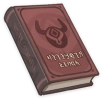
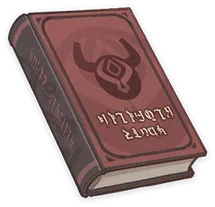 | Name | Hilichurl Cultural Customs (I) |
| Type (Ingame) | Quest Item | |
| Family | Book, Hilichurl Cultural Customs | |
| Rarity | ||
| Description | It contains the investigations and observations into the cultural customs of the hilichurls by the "Poet Laureate of Hilichurlian," Jacob Musk, a Mondstadt ecologist. This volume features the social structure and characteristics of the hilichurls. |
| Hilichurlian Social Structure The social structure of the hilichurl race is evidently a primitive, tribal one. Small-sized hilichurl tribes are prolific in occurrence throughout the wilderness. It seems that they conceive of the tribe as akin to a large, extended family. By far the most powerful figure in the hilichurl tribe is the Shaman. Extensive field research confirms that the Shaman is the oldest member of the tribe and plays a role in it analogous to that of the parent in the family: managing major affairs and making policy decisions, based on their wealth of experience. Additionally, Shamans act as protector to their tribe using their elemental abilities. Shamans can be identified by their distinctive appearance from other tribe members: They wear horned, smiling-face masks with eye holes at the mouth, and wield a rudimentary Shaman's staff in their hands. A further identifying feature is that they will be heard chanting to themselves some form of unintelligible hymn or incantation. Age is not always the deciding factor when it comes to status in the tribe. In some tribes, Shamans are ousted from leadership by physically larger hilichurls with superior combat skills. Under leadership of this kind, such tribes tend to become more aggressive. The chiefs of these tribes can easily be identified from their large stature and ostentatious masks, which also bear horns. The hilichurls' hostility towards outsiders, coupled with the obvious language barriers, means that conducting specific research on the distribution of resources within tribes has been all but impossible. Nevertheless, Knights of Favonius' patrol reports suggest that resources are typically shared on the basis of "to each according to his needs." All tribe members are both gatherers and soldiers, but some that prize combat above others develop into seasoned heavyweights of the battlefield. If the tribe stays long enough in an unfavorable environment, these heavyweights will become its most respected leaders. Interestingly, hilichurls seem to have a unique ability to manipulate the elements despite their low intelligence and primitive social structure. This ability is most notably manifested in the Shamans. Typically, humans require a Vision in order to exercise elemental control. The question of how hilichurls are able to do so without a Vision is, therefore, one that requires further investigation and analysis. |
Hilichurl Cultural Customs (II)
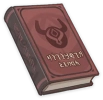
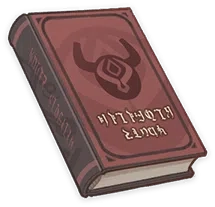 | Name | Hilichurl Cultural Customs (II) |
| Type (Ingame) | Quest Item | |
| Family | Book, Hilichurl Cultural Customs | |
| Rarity | ||
| Description | It contains the investigations and observations into the cultural customs of the hilichurls by the "Poet Laureate of Hilichurlian," Jacob Musk, a Mondstadt ecologist. This volume features the beliefs and spiritual world of the hilichurls. |
| Hilichurl Spirituality Just as the inhabitants of the Seven Nations of Teyvat each have their religious beliefs, so too do the hilichurls. However, they worship not a specific figurehead with a presence in this world — such as one of The Seven — but elemental power itself in a more abstract sense. For instance, some hilichurl tribes in Mondstadt revere Anemo just as their human counterparts do, but they do not recognize the Anemo Archon Barbatos. Instead, they worship the power of Anemo itself. Hilichurls holding different elemental beliefs often live together in the same tribe. An individual hilichurl's elemental affiliation can be deduced from the designs on their masks and the color of their body paint. Firsthand observations indicate that the Shaman, responsible for organizing offerings and worship ceremonies for the tribe, applies a colored dye to their hair and skin, with the color representing the element they worship. Shamans are dressed and adorned more ornately than ordinary tribe members, but owing to the limited intelligence of the hilichurls it is highly doubtful that any of the fine ornaments worn are crafted by their own hand. The Shaman is the spiritual leader of his tribe. He leads them in song and dance during worship, singing hymns of praise to the elements. If there is leftover meat from the hunt, the hilichurls place it on the altar, raw, as a sacrifice. Even though they accumulate ample Mora, precious stones, and other items of value through exploring, looting, mugging and other means, it would appear that raw meat alone is considered a sufficient sacrifice. It would appear that the hilichurls possess no concept of either the past or future, living only in the present. They do not intentionally store up food for survival, nor do they commemorate their deceased forebears. Though crude attempts at something like calligraphy have been widely observed within their camps, closer inspection reveals these markings to be nothing more than botched imitations of what they have seen in ancient ruins, possessing no originality whatsoever. Hilichurls do seem to have an inexplicable affinity for remnants of the past, evidenced by the fact that ruins are one of their preferred locations to camp. But investigations thus far have turned up nothing which might hint at the true nature of their connection with the lost civilizations to which these ruins belong. |
Hilichurl Cultural Customs (IV)
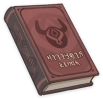
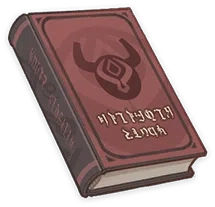 | Name | Hilichurl Cultural Customs (IV) |
| Type (Ingame) | Quest Item | |
| Family | Book, Hilichurl Cultural Customs | |
| Rarity | ||
| Description | It contains the investigations and observations into the cultural customs of the hilichurls by the "Poet Laureate of Hilichurlian," Jacob Musk, a Mondstadt ecologist. This volume explores the diverse cultural customs of the hilichurls in relation to Mondstadt's. |
| Dadaupa Gorge, Mondstadt: a Case for Cultural Diversity Among the Hilichurls The Meaty tribe is fond of feasting. They have built a boar-rearing pen in the center of their settlement and assigned a swineherd to watch over it. Over a natural stove made with a Pyro Slime, they cook boar stew in a single, large pot from which each tribe member feeds according to their needs. The most striking feature of this tribe is its sizable combat arena. Those who set foot in the arena are understood to be accepting an open invitation to engage in combat, and those subsequently ousted from it face being mocked by the entire tribe. The Sleeper tribe is prone to sleeping at every opportunity. They have built themselves an environment especially conducive to sleep, consisting of simple, wooden huts furnished with soft animal hide for beds. They are the most cunning and devious of the hilichurl tribes, and their above-average mental capacity can perhaps be attributed to the superior sleep quality they enjoy. The practices of the Eclipse tribe are the most occult of any in Mondstadt. They concern themselves neither with brains nor brawn, but with occult power. Distinct from the elemental powers worshiped by their peers, the object of their worship is a crude symbol that appears to represent an eclipsed sun. Their shamans are more powerful than those of the other tribes. In the center of their settlement, the other tribe members have built a grand throne for the most formidable of shamans who leads them. |
Hilichurl Cultural Customs (III)
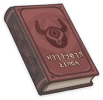
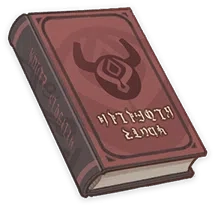 | Name | Hilichurl Cultural Customs (III) |
| Type (Ingame) | Quest Item | |
| Family | Book, Hilichurl Cultural Customs | |
| Rarity | ||
| Description | It contains the investigations and observations into the cultural customs of the hilichurls by the "Poet Laureate of Hilichurlian," Jacob Musk, a Mondstadt ecologist. This volume features mysterious hilichurls who live apart from the others. |
| The Mysterious Loners Among the Hilichurls exists a kind of mysterious, large creature possessing both immense physical strength and the ability to control the elements. They use this elemental ability to further enhance their physical state, such as to protect themselves or increase the brute force of their attacks — a combination making them nearly unstoppable. These powerful Hilichurls are called "Lawa" by the rest of the tribe, a respectful form of address best translated to mean "king" or "chief". However, Lawa don't actually rule over or lead the tribe at all. Rather, these large loners prefer solitude, avoiding the looks of reverence from the smaller Hilichurls. Adventurers very rarely encounter these gigantic creatures. Still, even the most seasoned adventurers will think twice before going on expeditions into areas where these dangerous Lawas may be roaming. |




The hypocrisy of this comment is lost on a you I guess